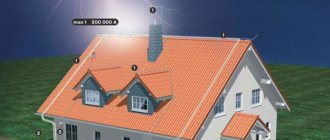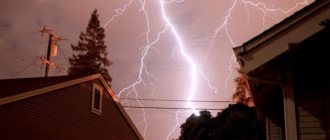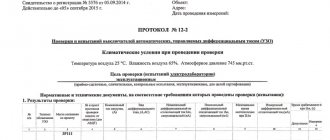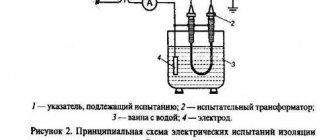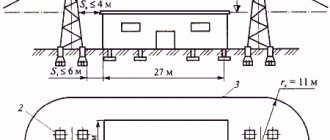Lightning protection systems should be checked for functionality from time to time. The need for such tests is dictated by ensuring the safety of both the building and the people in it. In addition, lightning rods are under constant negative influence of environmental factors, which can lead to a deterioration in their functionality.
Checking lightning protection is an important event that is carried out as planned or unscheduled if there are doubts about the operability of the system.
Types and frequency of inspections
Verification activities are usually divided into types:
- Scheduled inspection (another name is seasonal). Conducted according to a predetermined schedule.
- Extraordinary inspection. Carried out in the event of unforeseen events (for example, system failure).
- Start-up and introductory testing of protection.
Scheduled tests
The procedure for conducting scheduled testing is regulated by the standards established in instructions RD-34.22.121-87. Inspections are regulated by the provisions of the PUE (rules for the construction of electrical installations) and PTEEP (rules for the technical operation of consumer electrical installations). For outdoor protective devices, the rules are specified in paragraph 1.14 of RD-34.22.121-87.
In accordance with these standards, all protected objects are divided into categories. Based on the category established for the building or structure, the frequency of inspection of the lightning protection system is established. For example, for buildings of the first and second categories, tests should be carried out every year before the onset of thunderstorm season. The third category concerns objects exposed to minor danger. In this case, inspections should be carried out every three years.
Extraordinary tests
Inspections outside the planned schedule are carried out in the following cases:
- Making any changes to structural elements that were not initially included in the design documentation.
- Upon completion of repair work and reconstruction of the building.
- In the event of major accidents, catastrophes or natural disasters.
Start-up and introductory tests
They are carried out upon delivery of the protected building to the customer. Start-up testing is carried out immediately after completion of the main construction work or according to a previously agreed schedule for the reconstruction of the facility.
The results of the inspection are documented. Based on the conclusion, operation of the system begins.
What is the frequency of lightning protection checks?
The lightning protection system of a building requires periodic inspection.
The need for such measures is determined, firstly, by the importance of these devices for the safety of both the real estate itself and the people nearby, and secondly, by the fact that lightning rods are constantly exposed to adverse environmental factors. The first check of the lightning protection system is carried out immediately after installation. In the future, it is carried out at certain intervals established by regulations.
Frequency of inspections
The frequency of lightning protection inspection is determined in accordance with clause 1.14 RD 34.21.122-87 “Instructions for the installation of lightning protection of buildings and structures.” According to the document, for all categories of buildings it is carried out at least once a year.
In accordance with the “Rules for the technical operation of consumer electrical installations,” grounding circuits are checked:
Once every six months - visual inspection of visible elements of the grounding device;
Once every 12 years - inspection, accompanied by selective opening of the soil.
Measuring the resistance of ground loops:
Once every 6 years - on power lines with voltages up to 1000 V;
Once every 12 years - on power lines with voltages over 1000 V.
Lightning protection inspection system
Checking lightning protection includes the following activities:
- checking the connection between grounding and lightning rod
- measurement of the transient resistance of bolted connections of a lightning protection system
- grounding check
- insulation check
- visual inspection of the integrity of system elements (down conductors, lightning rods, points of contact between them), the absence of corrosion on them
- checking the compliance of the actually installed lightning protection system with the design documentation, the validity of installing this type of lightning rod at this facility
- testing the mechanical strength and integrity of welded joints of the lightning protection system (all joints are tapped with a hammer)
- determination of the grounding resistance of each individual lightning rod. During subsequent checks, the resistance value should not exceed the level determined during acceptance tests by more than 5 times.
The resistance of the lightning protection system is checked using the MRU-101 device. At the same time, the methodology for checking lightning protection may be different. The most common ones include:
- Resistance measurement in a lightning protection system using a three-pole circuit
- Resistance measurement in a lightning protection system using a four-pole circuit
The four-pole testing system is more accurate and minimizes the possibility of error.
It is best to check the grounding in conditions of maximum soil resistance - in dry weather or in conditions of greatest freezing. In other cases, correction factors are used to obtain accurate data.
Based on the results of the system inspection, a lightning protection inspection protocol is drawn up, which indicates the serviceability of the equipment.
What to pay attention to when checking lightning protection
It is unlikely that it will be possible to test the lightning protection system in action at the time of acceptance of work, since the likelihood that a thunderstorm will break out at this moment is very small. Therefore, you should pay attention to the progress of the verification:
- workers must inspect all visible parts of the lightning protection system, check the components and connections;
- resistance measurement should be carried out using a special measuring device (MRU-101);
- work must be carried out either in dry weather or when the soil is sufficiently frozen to avoid possible mistakes;
- Upon completion of the inspection, specialists must draw up a lightning protection inspection protocol of the established standard.
In order to eliminate unscrupulous inspections, which can lead to problems with putting the facility into operation and insufficient protection from lightning strikes, it is best to contact a reliable, proven company specializing in the installation of lightning protection systems.
Typically, checking a lightning protection system includes:
- visual inspection of the integrity of lightning rods and down conductors, the reliability of their connection and fastening to the masts;
- identification of elements of lightning protection devices that require replacement or repair due to a violation of their mechanical strength;
- determination of the degree of destruction by corrosion of individual elements of lightning protection devices;
- checking the reliability of electrical connections between live parts of all elements of lightning protection devices;
- checking the compliance of lightning protection devices with the intended purpose of the objects;
- measuring the resistance value to the spreading of pulsed current using the “ammeter-voltmeter” method using a specialized measuring complex.
The results of inspections are formalized in acts, entered into passports and a logbook for recording the condition of lightning protection devices. Based on the data obtained, a repair plan and elimination of defects in lightning protection devices discovered during inspections and checks is drawn up.
When and how are lightning protection devices checked?
A thunderstorm, as a natural phenomenon, is accompanied by lightning that strikes mainly tall objects. The high energy inherent in lightning discharges, under unfortunate circumstances, can lead to:
- destruction of elements of an architectural object;
- failure of electronic equipment;
- the occurrence of a fire;
- death of people and farm animals.
The only way to prevent this is a lightning protection device.
The purpose of lightning protection is to forcefully drain the atmospheric discharge current directly to the ground along a ground loop specially created for this purpose, which avoids its direct impact on building structures, animals and people. Lightning protection of a building is performed as a separate engineering system. The serviceability of the lightning protection system is confirmed by regular checks.
Stages of inspections
The task of scheduled, introductory and extraordinary resistance measurements and checks of lightning protection devices according to other parameters is to assess the compliance of the existing parameters with the regulations and design documents. For this purpose, the quality of installation work is examined, the condition of local sections of the system and contacts is determined. The goals of testing, the content and scope of tasks depend on the parameters of the object and the design features of the protection system.
Tests are carried out according to a certain algorithm:
- Compare the data available in the design documentation with real indicators.
- They check the compliance of protective zones and structures with the requirements of regulatory documents.
- Inspect protective devices, down conductors, and connecting contacts to check their integrity, the absence of traces of rust, and the quality of installation connections.
- Welds are checked for integrity and strength by applying mechanical forces (tapping with a hammer).
- Measure the resistance of bolted joints.
Measurements of the grounding resistance coefficient of lightning rods are carried out separately for each device. The final indicator should differ no more than five times from the data obtained during the introductory tests. If the grounding conductor performs a related task (working grounding conductor of the building and lightning protection system), there is no need for resistance measurements.
To obtain the most accurate results, planned and start-up testing work is carried out during the lowest level of moisture in the soil adjacent to the building. In regions belonging to permafrost zones, measurements are carried out during the period of maximum freezing of the ground.
Note! When testing the system, the level of atmospheric pressure is taken into account. This parameter is secondary, but is included in the final protocol.
Measuring equipment
High-precision equipment type M-416 is used for testing. The device is used in conjunction with a data meter for electrical safety of equipment and electrical installations (MPI-511). At the same time, existing standards allow the use of other measuring instruments with similar capabilities.
The resistance of the functional elements of the protective system is measured with the MRU-101 device. The device is capable of automatically stopping the test when emergency situations occur and displays the following indicators on the monitor:
- Overcoming 24V noise level (LIMIT and UN).
- Noise voltage exceeds 40B (LIMIT and OFL).
- No current current (-r- and test socket icon).
- The resistance level of the measuring probes is too high - over 50 kOhm (LIMIT and indicator on the probe).
- The meters exceed the standard range (OFL).
The noise voltage indicator is set by pressing the R button or by selecting the measurement function by turning the device switch.
The received data is not considered correct if the equipment has detected the following situations:
- Deviation of the resistance level of the probes by 30% (LIMIT).
- The battery is in a discharged state (BAT).
If there are no grounds for blocking or slight deviations of the input data from the standards, MTU-101 takes measurements and displays the following data:
- The amount of resistance in a given area.
- Probe resistance.
- Soil resistivity.
- Other indicators (for more information, press the SEL button).
Note! The measurement range for each parameter is determined automatically by the equipment.
Three-pole measuring system
For measuring the resistance of a lightning protection system, the method is considered basic. The work is carried out as follows:
- The ground electrode is connected to the measuring socket of the equipment.
- The current probe is directed into the ground. The measurement is carried out at a distance of over 40 meters from the protective system. The probe is connected with a special conductor to the socket of the device called “H”.
- The potential probe is installed in the ground at a distance of more than 20 meters from the protective system being studied. Next, the probe is connected to the measuring socket marked with the letter S.
- The probes and the ground electrode are lined up in a single line.
The rotary switch is placed in position RE 3p. Next, measurements begin after pressing the START key.
After the procedure is completed, the ground resistance indicator (RE) and the data obtained from the probes appear on the monitor. The distance between the potential probe and the protective system is reduced to one meter. Then they take another measurement. If the results differ by more than 3%, the current probe is moved further away. The measurement is carried out repeatedly until an acceptable ratio of the obtained data is obtained.
Measurements using a three-pole circuit involve taking into account several nuances. For example, with increased resistance of the probes, this indicator for grounding is set with a certain error. The same should be said about measurements of the resistance of the ground loop, which is in free contact with the ground. The reason for the existing errors is the excessively high ratio of the resistance of the probes and the ground electrode.
To improve the accuracy of the data obtained, it is necessary to achieve better contact of the probes with the ground. For this purpose, the probes are moved to another, more humid place. An alternative to this solution is to artificially moisten the soil before performing the test. In addition, you need to inspect the measuring conductors to ensure the integrity of the insulating material, the absence of traces of rust, and check the contacts with the probe terminals.
Note! The results of all additional procedures are recorded in the final protocol.
Compliance with all recommended conditions allows you to obtain fairly accurate results (taking into account the general measurement error). It should be borne in mind that a correct assessment of the influence of the resistance of the probes requires additional calculations.
Categories of premises and frequency of inspection
The rules for operating electrical equipment of PTEEP (Chapter 2.8) according to the level of protection against lightning strikes divide all architectural objects into three categories.
Category I includes those industrial facilities that are prone to the formation of accumulations of fire and explosive materials in gaseous, vaporous or dusty form. Moreover, it is acceptable that in an emergency situation not only the personnel of the enterprise, but also nearby structures may suffer.
Category II differs from the previous one in that the provisions of the verification methodology intended for it apply to:
- architectural objects in which the accumulation of potentially hazardous environments occurs only in the event of technology violations or malfunctions of process equipment;
- various external installations using liquid or gaseous explosive and/or flammable materials.
Other equipment whose safety is ensured by a lightning protection system is classified as category III . His lightning strike is not as dangerous or causes less damage.
The frequency of checking the parameters of the lightning protection system with the issuance of test reports, which is established by regulations and belongs to the group of control measurements, depends on the category. For categories I, II this is 1 year, for category III the periodic inspection interval is once every three years. Additionally, resistance measurements of annual inspections should be carried out before the start of the thunderstorm season.
Extraordinary and one-time inspections are performed as the need arises.
Once every six years, the degree of corrosion of grounding conductors is assessed.
Source
Four-pole measurements
If particularly high accuracy of results is required, errors must be eliminated. Using a four-pole circuit will help in this matter.
Measurements are carried out as follows:
- The receiver is connected to the equipment sockets marked E and ES.
- Both probes are installed in the same way as in the three-pole method.
- The rotary switch is directed to position RE 4p.
- Press the START button.
- Record the obtained data on the grounding resistance and probes (Rs and RH). The data is displayed on the monitor.
The measuring probe is moved one meter from the protective system. After this, measurements are made again. The results obtained are interpreted in the same way as in the case of using a three-pole system. At the end of the study, the data is entered into the final protocol.
Note! Regardless of the scheme used, the norm is considered to be a distance of the potential probe to a value equal to 62% of the distance between the system under study and the current probe.
Types of lightning protection checks
Checks of lightning protection components are divided into one-time (for example, a test at the end of system installation), control (carried out on a schedule) and extraordinary.
- One-time. Performed upon completion of the installation of the system, in case of damage to the structure on which it is installed, during repair of the system, as well as during work to change its circuit, re-equipment of circuits;
- Extraordinary. Carried out after severe thunderstorms and natural phenomena (for example, earthquakes, floods, etc.), without carrying out resistance measurements, by visual inspection;
- Tests. They include a full cycle of control measures, with changes in system parameters according to an established plan.
Documenting results
The main document indicating the reliability of the data obtained is the test report of the protective system. This document shows all the required performance characteristics. Separate paragraphs indicate the results of the measurements obtained and indicate the test conditions.
During introductory testing, working passports are issued. When the tests are completed, the owner of the object or his authorized representative is given documents indicating the results of the test.
Checking the lightning protection system is a critically important activity. The lives of people and the safety of material assets depend on how well the work is done. To carry out the inspection, it is recommended to contact reliable service providers who specialize in this type of work and have a good reputation.


